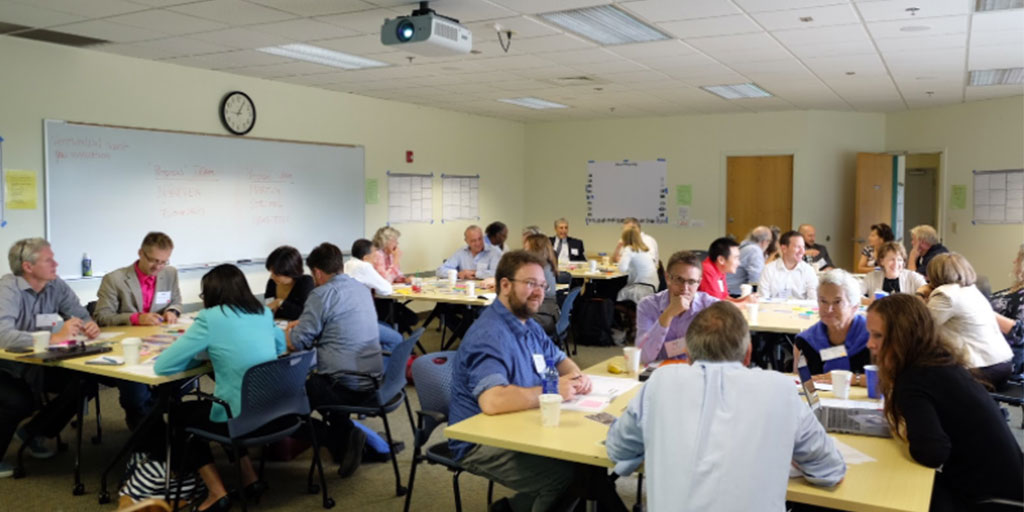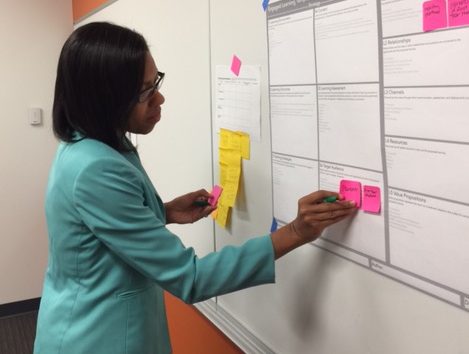
As education reforms run into headwinds and higher education funding shrinks, colleges and universities across the nation are leveraging new approaches and tools to catalyzing and sustaining institutional change. One approach we’ve integrated into our work is called collective impact.
Collective impact as described by Kania and Kramer is a process to bring together the efforts of a group of committed collaborators, often from different perspectives to work together to accomplish a common agenda and solve a shared and defined problem. These “communities of practice” are built on the premise that, in order for powerful transformations to take place, key collaborators need to be engaged and must work in concert. The work of Etienne Wenger and his colleagues describes how these communities foster institutional change through their shared passion, defined focus, and peer accountability, and learn how to better effect that change through regular interaction.
Unlike most collaborations, however, collective impact initiatives work best when there is a centralized infrastructure with a dedicated team and a clear process to coordinate and help weave the community together. The work of Wenger has shown that successful collective impact initiatives require five conditions to produce true alignment and yield powerful results:
- Common agenda: A shared set of goals. While these goals may vary between organizations, they should exist in the same area of practice and involve similar overall endpoints or overarching missions.
- Shared measurement: Having consistent standards across institutions is key to effective communication and collaboration. At the outset, organizations should create processes for setting goals and measuring progress.
- Continuous improvement: Collective development is a long-range approach; a multi-year change initiative rather than a short-term project. It requires reaching many small milestones and constantly improving outcomes.
- Regular communication: Communication is essential to effectively executing this approach and creating lasting community connections. Sharing updates and progress through peer-to-peer interactions, convenings, and data-driven reports maintains strong relationships within the collective.
- Strong backbone: The role of the backbone organization is to support this activity. The organization commits to providing tools and resources, engaging and convening change agents, and holding participants accountable for measurement and improvement.

At VentureWell, our approach to supporting institutional change is community-centric and aligned with the collective impact model. Our work as a backbone organization supporting network development and effectiveness has grown and evolved as we’ve deployed techniques that are effective and based in social science. We’ve applied these approaches in multiple institutional change communities – from networks focused on equity and student success in the Bill & Melinda Gates Foundation Frontier Set program to increasing community engagement in the Industry-University Cooperative Research Centers Program (IUCRC) initiative.
VentureWell programs like Pathways in Innovation is designed to support change by convening collaborator teams in highly engaging, interactive formats, extracting and spreading useful practices, and providing hands-on support to help geographically distributed teams achieve institutional transformation. At our annual OPEN conference, we empower innovators to connect with their peers, share and validate their ideas, communicate emerging best practices with the wider innovation and entrepreneurship community, and begin new collaborations with partners.
We are excited by the opportunity to continue learning, to deepen our understanding of the conditions that lead to transformation and effective scaling, and to build on the work we’ve done.
VentureWell Faculty Grants provide up to $30k to help create new or transform existing courses and programs on campus. Learn more and apply here.
 Since 1996, Phil has been the chief executive of VentureWell. From the beginning, Phil’s focus for VentureWell has been to help bring socially beneficial applications of STEM inventions to market. He’s accomplished this goal by designing and overseeing programs that encourage curricular innovation and student venture creation, provide resources for faculty and student entrepreneurs, and develop community through conferences and workshops for faculty and students.
Since 1996, Phil has been the chief executive of VentureWell. From the beginning, Phil’s focus for VentureWell has been to help bring socially beneficial applications of STEM inventions to market. He’s accomplished this goal by designing and overseeing programs that encourage curricular innovation and student venture creation, provide resources for faculty and student entrepreneurs, and develop community through conferences and workshops for faculty and students.
Phil attended the University of Massachusetts where he was a co-founder of a biotechnology company developing naturally occurring pest control products. He is a Founder and Past Chair of the ASEE Entrepreneurship Division, and a recipient of the 2008 Price Foundation Innovative Entrepreneurship Educators Award, the 2014 Engineering Entrepreneurship Pioneers Award from ASEE, and the 2016 Deshpande Symposium Award for Outstanding Contributions to Advancing Innovation and Entrepreneurship in Higher Education.